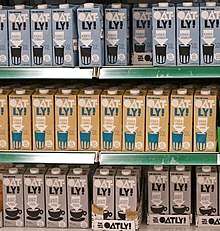Plant milk
Plant milk (plant-based liquids, alternative milk, nut milk or vegan milk) refers to manufactured, nondairy beverages made from a water-based plant extract for flavouring and aroma.[1][2] Plant milks are vegan beverages consumed as plant-based alternatives to dairy milk, and often provide a creamy mouthfeel.[3] For commerce, plant-based liquids are typically packaged in containers similar and competitive to those used for animal lactations, but cannot be labeled as "milk" within the European Union.[4] In 2018, among the roughly 20 plants used to manufacture plant milk, almond, soy, and coconut were the highest-selling plant milks worldwide. The global plant milk market was estimated at US$16 billion in 2018.[3]
| Type | Nondairy beverage and ingredient |
|---|---|
| Color | White |
| Flavor | Various; creamy texture |
| Ingredients | Water and a grain, pseudocereal, legume, nut, seed, or coconut (which is a drupe as defined by the US Library of Congress) |


Plant-based beverages have been consumed for centuries, with the term "milk-like plant juices" used since the 13th century.[5] Across various cultures, plant milk has been both a traditional beverage and a flavourful ingredient in sweet and savory dishes, such as the use of coconut milk in curries. Plant milks are also used to make "ice cream", plant cream, vegan cheese, and "yogurt", such as soy yogurt. A 2018 study found that 54% of U.S. consumers "would like to eat more plant-based foods and beverages".[6]
History
Horchata, a beverage originally made in North Africa from soaked, ground, and sweetened tiger nuts, spread to Iberia (now Spain) before the year 1000.[7][8] In English, the word "milk" has been used to refer to "milk-like plant juices" since 1200 AD.[5]
Recipes from the 13th-century Levant exist which describe the first plant milk: almond milk.[9] Soy was a plant milk used in China during the 14th century.[3][7] In Medieval England, almond milk was used in dishes such as ris alkere (a type of rice pudding)[10] and appears in the recipe collection, The Forme of Cury.[11] Coconut milk (and coconut cream) are traditional ingredients in many cuisines such as in South and Southeast Asia, and are often used in curries.[12]
Plant milks may be regarded as milk substitutes in Western countries, but have traditionally been consumed in other parts of the world, especially ones where there are higher rates of lactose intolerance (see especially lactose intolerance: epidemiology section).[2]
Types
Common plant milks are almond milk, coconut milk, rice milk, and soy milk. Other plant milks include hemp milk, oat milk, pea milk, and peanut milk.[2][13][14]
Plant milks can be made from:
- Grains: barley, fonio, maize, millet, oat, rice, rye, sorghum, teff, triticale, spelt, wheat
- Pseudocereals: amaranth, buckwheat, quinoa
- Legumes: lupin, pea, peanut, soy
- Nuts: almond, brazil, cashew, hazelnut, macadamia, pecan, pistachio, walnut
- Seeds: chia seed, flax seed, hemp seed, pumpkin seed, sesame seed, sunflower seed
- Other: coconut (fruit; drupe), potato (tuber), tiger nut (tuber)
A blend is a plant milk created by mixing two or more types together. Common examples of blends are almond-coconut milk and almond-cashew milk. Pacific Foods' 7 Grain plant milk consists of oat, rice, triticale, wheat, barley, spelt, and millet.
Other traditional plant milk recipes include:
Manufacturing
| Milk Types | Greenhouse Gas Emissions (kg CO2-Ceq per 200 g) |
|---|---|
| Cow's Milk | 0.62 |
| Rice Milk | 0.23 |
| Soy Milk | 0.21 |
| Oat Milk | 0.19 |
| Almond Milk | 0.16 |
| Milk Types | Water Use (L per 200 g) |
|---|---|
| Cow's Milk | 131 |
| Almond Milk | 74 |
| Rice Milk | 56 |
| Oat Milk | 9 |
| Soy Milk | 2 |
| Milk Types | Land Use (m2 per 200 g) |
|---|---|
| Cow's Milk | 1.81 |
| Oat Milk | 0.25 |
| Soy Milk | 0.23 |
| Almond Milk | 0.19 |
| Rice Milk | 0.14 |
Although there are variations in the manufacturing of plant milks according to the starting plant material, as an example, the general technique for soy milk involves several steps, including:[2][3][16]
- cleaning, soaking and dehulling the beans
- grinding of the starting material to produce a slurry, powder or emulsion
- heating the processed plant material to denature lipoxidase enzymes to minimize their effects on flavor
- removing sedimentable solids by filtration
- adding water, sugar (or sugar substitutes) and other ingredients to improve flavour, aroma, and micronutrient content
- pasteurizing the pre-final liquid
- homogenizing the liquid to break down fat globules and particles for a smooth mouthfeel
- packaging, labeling and storage at 1 °C (34 °F)
The actual content of the highlighted plant in commercial plant milks may be only around 2%.[3] Other ingredients commonly added to plant milks during manufacturing include guar gum, xanthan gum, or sunflower lecithin for texture and mouthfeel, select micronutrients (such as calcium, B vitamins, and vitamin D), salt, and natural or artificial ingredients—such as flavours characteristic of the featured plant—for aroma, color, and taste.[2][3][16][13] Plant milks are also used to make ice cream, plant cream, vegan cheese, and yogurt, such as soy yogurt.
The production of almond-based dairy substitutes has been criticized on environmental grounds as large amounts of water and pesticides are used.[17][18] The emissions, land, and water footprints of plant milks vary, due to differences in crop water needs, farming practices, region of production, production processes, and transportation.[15]
Nutritional comparison with cow's milk
Generally, because plant milks are manufactured using processed extracts of the starting plant, plant milks are lower in nutrient density than dairy milk and are fortified during manufacturing to add precise levels of micronutrients.[3][13][14]
| Nutritional content of cow, soy, almond and oat milks | ||||
|---|---|---|---|---|
| Nutrient value per 243 g cup |
Cow milk (whole, vitamin D added)[19] |
Soy milk (unsweetened; calcium, vitamins A and D added)[20] |
Almond milk (unsweetened)[21] |
Oat milk (unsweetened)[22] |
| Energy, kJ (kcal) | 620 (149) | 330 (80) | 160 (39) | 500 (120) |
| Protein (g) | 7.69 | 6.95 | 1.55 | 3 |
| Fat (g) | 7.93 | 3.91 | 2.88 | 5 |
| Saturated fat (g) | 4.55 | 0.5 | 0 | 0.5 |
| Carbohydrate (g) | 11.71 | 4.23 | 1.52 | 16 |
| Fiber (g) | 0 | 1.2 | 0 | 2 |
| Sugars (g) | 12.32 | 1 | 0 | 7 |
| Calcium (mg) | 276 | 301 | 516 | 350 |
| Potassium (mg) | 322 | 292 | 176 | 390 |
| Sodium (mg) | 105 | 90 | 186 | 140 |
| Vitamin B 12 (µg) | 1.10 | 2.70 | 0 | 1.2 |
| Vitamin A (IU) | 395 | 503 | 372 | 267 |
| Vitamin D (IU) | 124 | 119 | 110 | 144 |
| Cholesterol (mg) | 24 | 0 | 0 | 0 |
Packaging and commerce
To improve competition, plant milks are typically packaged in containers similar to those of dairy milks.[1][23][24] Advertising for plant milks may contrast the intensive farming effort to produce dairy milk with the relative ease of harvesting vegan sources, such as oats, rice or soybeans.[3][25]
In the United States, plant milk sales grew steadily by 61% over the period 2012 to 2018.[26] Among plant milks, almond (64% market share), soy (13% market share), and coconut (12% market share) were category leaders in the United States during 2018.[26] Oat milk sales increased by 250% in Canada during 2019,[27] and its growing consumption in the United States and United Kingdom led to production shortages from unprecedented consumer demand.[28][29] In 2020, one major coffee retailer – Starbucks – added oat milk, coconut milk, and almond milk beverages to its menus in the United States and Canada.[30]
Labeling and terminology
Plants milks may be labeled to highlight their nutrient contents, or with terms reflecting their composition or absence of ingredients, such as "dairy-free", "gluten-free" or "GMO-free".[3]
Traditionally a variety of non-dairy products have been described with the word milk, including the traditional digestive remedies milk of magnesia[31] and milk of bismuth.[32] Latex, the complex inedible emulsion that exudes from the stems of certain plants, is generally described as milky and is often sold as "rubber milk" because of its white appearance. The word latex itself is deducted from the Spanish word for milk.[33]
In December 2013, European Union regulations stated that the terms "milk", "butter", "cheese", "cream" and "yoghurt" can only be used to market and advertise products derived from animal milk, with a small number of exceptions including coconut milk, peanut butter and ice cream.[34] In 2017, the Landgericht Trier (Trier regional court), Germany, asked the Court of Justice of the European Union, to clarify European food-labeling law (Case C-422/16),[35] with the court stating that plant-based products cannot be marketed as milk, cream, butter, cheese or yoghurt within the European Union because these are reserved for animal products; exceptions to this do not include tofu and soy. In the United Kingdom, strict standards are applied to food labeling for terms such as milk, cheese, cream, yogurt, which are protected to describe dairy products and may not be misused to describe non-dairy produce.[36]
In the United States, the dairy industry petitioned the FDA to ban the use of terms like "milk", "cheese", "cream" and "butter" on plant-based analogues (except for peanut butter).[37] FDA commissioner, Scott Gottlieb, stated on July 17, 2018 that the term "milk" is used imprecisely in the labeling of non-dairy beverages, such as soy milk, oat milk and almond milk: "An almond doesn't lactate", he said.[1] In 2019, the US National Milk Producers Federation petitioned the FDA to restrict labeling of plant-based milks, claiming they should be described as "imitation".[38] In response, the Plant-Based Foods Association stated the word "imitation" was disparaging, and there was no evidence that consumers were misled or confused about plant-based milks.[38] A 2018 survey by the International Food Information Council Foundation found that consumers in the United States do not typically confuse plant-based analogues with animal milk or dairy products.[37][39] Labeling regulations for plant-based products with names such as "milk" or "yoghurt" were under review, as of 2018.[40]
See also
References
- Benjamin Kemper (15 August 2018). "Nut Milks Are Milk, Says Almost Every Culture Across the Globe". The Smithsonian. Retrieved 20 March 2019.
- Sethi, Swati; Tyagi, S. K.; Anurag, Rahul K. (2 September 2016). "Plant-based milk alternatives an emerging segment of functional beverages: a review". Journal of Food Science and Technology. 53 (9): 3408–3423. doi:10.1007/s13197-016-2328-3. ISSN 0022-1155. PMC 5069255. PMID 27777447.
- Oliver Franklin-Wallis (29 January 2019). "White gold: the unstoppable rise of alternative milks". The Guardian. Retrieved 20 March 2019.
- "Dairy names for soya and tofu face new ban". 14 June 2017. Retrieved 8 June 2019.
- "Milk: Origin and meaning of milk". Online Etymology Dictionary, Douglas Harper. Retrieved 4 November 2018.
- Donna Berry (6 December 2018). "State of the industry: Dairy". Food Business News. Retrieved 20 March 2019.
- Zaslovsky, Nancy. "horchata". In Goldstein, Darra (ed.). The Oxford Companion to Sugar and Sweets. Oxford University Press. p. 341. Retrieved 4 July 2018.
- Cho, Susan; Almeida, Nelson (29 May 2012). Dietary Fiber and Health. CRC Press. ISBN 9781439899373 – via Google Books.
- Muhammad bin Hasan al-Baghdadi (1226), The Book of Dishes (in Arabic), Baghdad
- McSparran, Frances. "Middle English Dictionary Entry". Middle English Dictionary. University of Michigan. Retrieved 4 November 2018.
- Fraser, Andrew. "Cooking in the Middle Ages, recipe reconstruction". History Alive. Queensland Living History Federation. Retrieved 4 November 2018.
- Powell V. A brief history of plant milks. Vegan Food & Living. Accessed 11/30/2019
- Meagan Bridges (1 January 2018). "Moo-ove Over, Cow's Milk: The Rise of Plant-Based Dairy Alternatives" (PDF). Practical Gastroenterology, Nutrition Issues in Gastroenterology, Series #171; University of Virginia School of Medicine. Retrieved 20 March 2019.
- Vanga, Sai Kranthi; Raghavan, Vijaya (2 November 2017). "How well do plant based alternatives fare nutritionally compared to cow's milk?". Journal of Food Science and Technology. 55 (1): 10–20. doi:10.1007/s13197-017-2915-y. ISSN 0022-1155. PMC 5756203. PMID 29358791.
- Clara Guibourg and Helen Briggs (22 February 2019). "Which vegan milks are best for the planet?". BBC News - Science and Environment. Retrieved 4 September 2019.CS1 maint: uses authors parameter (link)
- Zeki Berk (1992). Soymilk and related products; In: Technology of production of edible flours and protein products from soybeans. UN Food and Agriculture Organization. ISBN 92-5-103118-5. Retrieved 20 March 2019.
- "UCSF Sustainability". sustainability.ucsf.edu. Retrieved 8 June 2019.
- Naylor, Tony (5 September 2018). "Ditch the almond milk: why everything you know about sustainable eating is probably wrong". The Guardian. ISSN 0261-3077. Retrieved 8 June 2019.
- "Milk, whole, 3.25% milkfat, with added vitamin D". Agricultural Research Service. United States Department of Agriculture.
- "Soymilk (all flavors), unsweetened, with added calcium, vitamins A and D". Agricultural Research Service. United States Department of Agriculture.
- "Beverages, almond milk, unsweetened, shelf stable". Agricultural Research Service. United States Department of Agriculture.
- Oat Milk Nutrition Facts (Report). Batavia, IL: Aldi.
- Dayna Fields (31 January 2019). "Investors Thirst For Plant-Based Milks". Forbes. Retrieved 20 March 2019.
- Charlotte Rogers (2 January 2019). "How marketing is fuelling the 'post-milk generation'". Marketing Week. Retrieved 20 March 2019.
- Tim Lewis (11 November 2018). "How we fell out of love with milk". The Guardian. Retrieved 20 March 2019.
- "US non-dairy milk sales grow 61% over the last 5 years". Mintel. 4 January 2018. Retrieved 20 March 2019.
- Alex Soloducha (7 November 2019). "From oat field to coffee shop: The latest non-dairy star is grown in Canada". CBC News. Retrieved 17 January 2020.
- Zara Stone (3 June 2019). "How oat milk conquered America". Elemental. Retrieved 12 September 2019.
- Bethan Staton (21 November 2018). "Non-dairy surge leads to oat milk shortage in UK". Sky News. Retrieved 12 September 2019.
- Nivedita Balu (7 January 2020). "Starbucks launches oat milk drink as vegan movement grows". The Chronicle Herald. Saltwire Network. Retrieved 22 February 2020.
- When was Phillips' Milk of Magnesia introduced? FAQ, phillipsrelief.com, accessed 4 July 2016
- Park & Davis Co catalog entry for milk of bismuth
- Raulf, Monika. The Latex Story. In: History of Allergy, K.-C. Bergmann and J. Ring, editors. Karger Medical and Scientific Publishers, 2014. pp. 248-255.
- "EU court bans dairy-style names for soya and tofu". BBC News. 14 June 2017. Retrieved 23 December 2018.
- "Judgment in Case C-422/16 Verband Sozialer Wettbewerb eV v TofuTown.com GmbH" (PDF). Court of Justice of the European Union. Luxembourg. 14 June 2017. Retrieved 23 December 2018.
- "Food standards: labelling and composition". Gov.UK. Retrieved 8 February 2020.
- "What's in a Name?: The Use of Dairy Product Names in Labeling of Plant-Based Alternatives". Science Meets Food. 13 December 2018. Retrieved 23 December 2018.
- Watson, Elaine (22 February 2019). "Plant-based 'milks' should be labeled as 'imitation,' 'alternative,' or 'substitute' products, says NMPF petition". FoodNavigator-USA.com, William Reed Business Media. Retrieved 8 February 2020.
- "What's in a Name? Survey Explores Consumers' Comprehension of Milk and Non-Dairy Alternatives". FoodInsight.org. 11 October 2018. Archived from the original on 30 December 2018. Retrieved 23 December 2018.
- "Use of the Names of Dairy Foods in the Labeling of Plant-Based Products". Federal Register. 28 September 2018. Retrieved 23 December 2018.
External links
- Wikibooks Cookbook category for Nut and Grain Milk recipes
